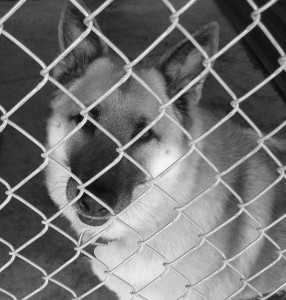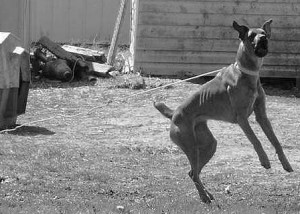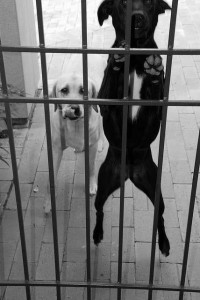Blunt Force Trauma – Canine Reality
![]() Eric Brad challenges some commonly held belief about dogs and says good training is not about being a pack leader or gaining respect.
Eric Brad challenges some commonly held belief about dogs and says good training is not about being a pack leader or gaining respect.
I’m a dog trainer. I love dogs. I have loved and enjoyed the company of dogs for most of my life. For a long time, I thought I knew dogs and how to live with them. Then I read some things that both shocked and enlightened me to the realities of dogs. From their origins and biology to their behaviour and integration into human society, I found I was tragically under informed about the realities of the dogs all around us. Perhaps I have seen too many websites or watched too many dog trainers on TV, but I’ve just hit the wall on one issue I feel I need to address. The squeamish among you may wish to stop reading now.
 Your dog is a captive. A hostage. He has precious little hope of escape unless you are careless or deliberate in getting rid of him. He is a domesticated animal, considered by most municipalities a piece of property to be treated like an appliance or piece of furniture under the legal system. He resides in your home at your pleasure and through no fault or choice of his own. Such is the state of existence of most dogs. That’s just the reality of the situation.
Your dog is a captive. A hostage. He has precious little hope of escape unless you are careless or deliberate in getting rid of him. He is a domesticated animal, considered by most municipalities a piece of property to be treated like an appliance or piece of furniture under the legal system. He resides in your home at your pleasure and through no fault or choice of his own. Such is the state of existence of most dogs. That’s just the reality of the situation.
How we, as caretakers of our charges, choose to deal with them is a fascinating study in diversity. Do most dogs suffer horribly? Certainly not, although some do. Most dogs are treated as cherished family members and others are treated with great care as working members of our society — as assistance dogs or working in law enforcement or other jobs. Regardless of how well or poorly a dog is cared for by humans, the one option generally not open to them is to just up and leave.
Getting Respect
In preparing to write this column each week, I search the web and read sites of other dog trainers to get different viewpoints and information. One recurring theme on many of these websites is “gaining your dog’s respect.” In her article How To Gain Your Dog’s Respect, author Danielle Niesz makes the assertion that owners must gain their dogs’ respect and “The only real way to go about this is to become your dogs’ pack leader.”
Niesz goes on to claim that “if you establish your dominance, your dogs will not question your position as pack leader, making your life easier and your dog’s more fulfilling.”
Establish my dominance over my dog? Seriously?! I have the power to starve her to death! Virtually everything in my dog’s life comes through me — toys, treats, food, water, exercise, companionship, a place to live, everything. Perhaps I don’t have a proper definition of dominance, but being a captive audience as she is, I would say that my dog is completely dominated by me in every important material way. I could, on a whim, deposit her at a shelter to be euthanized.
“But we love our dogs!” you may protest. Apparently this isn’t enough. Dog trainer and radio host Kevin Salem says, “sure, it [using food treats to train] builds trust, love and affection, but never respect!” So it’s not about whether you love your dog or not. It’s not even about whether your dog loves or trusts you. It’s about “respect”, a concept described by psychology professor Jonathan Haidt as one of the five fundamental moral values in his Moral Foundations Theory.
Are dog trainers who insist that the dog must “respect” the owner really suggesting that our dogs have a moral compass? To date, nothing even remotely close to this level of complexity has been proven to exist in the cognitive abilities of dogs.
Respect? Who Needs it.
 Even famous TV dog trainer and author Cesar Millan refers to “respect” when talking about dogs and their owners. One website quotes Millan as saying, “Dogs enjoy having a leader who they trust and respect, and who routinely fulfills their needs: exercise, discipline and affection.” Millan is often seen providing “discipline” to misbehaving dogs on his television show, as shown in this video. But a post by New Yorker magazine author Malcolm Gladwell — who has viewed hours of unedited video of Millan and written about him — paints a different picture.
Even famous TV dog trainer and author Cesar Millan refers to “respect” when talking about dogs and their owners. One website quotes Millan as saying, “Dogs enjoy having a leader who they trust and respect, and who routinely fulfills their needs: exercise, discipline and affection.” Millan is often seen providing “discipline” to misbehaving dogs on his television show, as shown in this video. But a post by New Yorker magazine author Malcolm Gladwell — who has viewed hours of unedited video of Millan and written about him — paints a different picture.
According to a blog post by Gladwell, the use of physical “discipline” on the dogs in Millan’s TV show is greatly exaggerated by selective editing for airing on the television program. Gladwell writes, “…over the course of an hour or more with a particular dog, he [Millan] might only “touch” the dog once or twice, and only in response to very specific behaviors.”
So, questions about the wisdom of using physical force to earn “respect” aside, the producers of the show are choosing to over emphasize the importance of “respect” in working with dogs. Do we really need to see the dog “respecting” Cesar so much that the editors take out the non-confrontational stuff and leave us with Millan showing the dog who’s boss? Given the popularity of the show, the answer seems to be yes.
So where does this need for outward signs of “respect” in dog owners come from? In 1954 psychologistAbraham Maslow published his book Motivation and Personality in which he suggests that a need for respect from others is a basic need in humans. Is our need to see outward signs of “respect” in our dogs’ behaviour towardsus about the dog’s behaviour or is it really about our basic human need to feel “respected” by those around us? Our current understanding of the limitations of what dogs can comprehend suggests that they can’t conceptualize “respect” much less deliberately choose to demonstrate that “respect” in their behaviour. Could it be that we are simply projecting our own needs onto a captive audience in our dogs?
The Power of Words
To be fair on the issue, I’ve also noted that most of the websites that talk about “respect” and “discipline” with regard to dogs are really getting at an important (and much more benign) point. The authors emphasize structure and consistency in working with dogs whether they advocate reward-based or punishment-based training. Those of us who use behavioural science to train our animals refer to this as using “contingencies” to manage behaviour. It’s a simple “If-Then” equation; IF you do this, THEN this will happen. The outcome is contingent on the preceding behaviour or situation.
I just need to provide a clear and consistent structure for my dog to understand our life together. This would be what some dog trainers call “setting the rules” or “defining the boundaries”. But it has nothing to do with “getting respect” and everything to do with educating my dog about how to operate successfully in my home!
 But what of the dogs that have their owners “wrapped around their little paw”, the ones that can get what they want when they want? You know, the dogs you see on TV shows; the worst of the worst-behaved dogs. Along with the power to starve or abandon your dog also comes the power to create the most bizarre behaviours so the dogs get what they want. That dog that barks incessantly at two in the morning is likely doing it because someone lets her out when she does. The dog that jumps all over mommy is likely doing so because it’s a sure-fire mechanism to get attention from mommy who probably feels guilty for her busy life and gives her “baby” a cookie in response to that jumping.
But what of the dogs that have their owners “wrapped around their little paw”, the ones that can get what they want when they want? You know, the dogs you see on TV shows; the worst of the worst-behaved dogs. Along with the power to starve or abandon your dog also comes the power to create the most bizarre behaviours so the dogs get what they want. That dog that barks incessantly at two in the morning is likely doing it because someone lets her out when she does. The dog that jumps all over mommy is likely doing so because it’s a sure-fire mechanism to get attention from mommy who probably feels guilty for her busy life and gives her “baby” a cookie in response to that jumping.
Pack of Lies
Meanwhile, back at our “Pack Leader” scenario, it has beenproven through scientific study that the dog is NOT a pack animallike the wolf or coyote. Dogs have evolved into lone scavengers and are now a far cry from their pack-hunting ancestors, the wolves.
Once in our homes, dogs do have a need to understand the “rules” of how to be successful — how to avoid the punishments and how to earn the rewards. Do I need to establish myself as a “Pack Leader” in order to do this? No. Do I need to use “calm assertive energy”? No. Do I need to get my dog’s “respect” or show my dominance over her? Of course not, and there’s one simple reason for this: people have thumbs. Thumbs allow us to use can openers, door knobs, water faucets, gates, and cars. In short, they allow us to provide for or abuse our dogs at our discretion.
Where is This Going?
So the debate rages on. Positive training? Calm assertive energy? Spare the rod and spoil the child? Treats are good? Treats are bad? Show them who’s boss? Teach them how to be successful? Remarkably (to me, anyway) the debate seems to turn more on which human being is the better trainer and the clever application of whatever training philosophy they espouse. It’s all about results and sometimes about “respect.” Look what my dog can do (or in some cases, won’t do).
 What of the dog? What about the hostage that has to put up with whatever comes at him? The choice is simple — put up with whatever it is or lash out at the human. That second choice is always a last resort for the dog and it never ends well for him. So the captive has to figure it out to survive. As I have said many times “all dog training works — eventually” and it works for a simple reason: if your dog cannot figure out what your want form him, the outcome is unpleasant so the hostage is very motivated to do it your way.
What of the dog? What about the hostage that has to put up with whatever comes at him? The choice is simple — put up with whatever it is or lash out at the human. That second choice is always a last resort for the dog and it never ends well for him. So the captive has to figure it out to survive. As I have said many times “all dog training works — eventually” and it works for a simple reason: if your dog cannot figure out what your want form him, the outcome is unpleasant so the hostage is very motivated to do it your way.
Without the structure that many trainers allude to (but don’t always clearly articulate), it can be difficult for my dog to figure out what the heck works in this crazy place. I just need to communicate effectively. No poking, no kicking, no confusion, no inconsistency. Yes is yes and no is no.
It’s time we stopped putting the blame on the dogs, the hostages that are just trying to survive in our quirky, complex, sometimes inconsistent human world. We need to place full responsibility on ourselves. We are the ones that have the big brains. We are the ones who make the rules and enforce them (more or less consistently). We are the ones who can kill them or abandon them at any time we choose to do so.
Respect? Leadership? Dominance? I have thumbs. Everything else is just excuses.
No comments:
Post a Comment